After a 1460% Surge, Reassessing ZEC's Value Proposition
History has repeatedly proven that a very short payback period (ultra-high ROI) is often a precursor to mining difficulty and price collapse.
Original Author: Lacie Zhang, Researcher at Bitget Wallet
The Origin of a Myth, the Prelude to a Collapse
Over the past two months, Zcash ($ZEC) has become the shining star of the entire cryptocurrency market. Soaring from $50 at the end of September to a recent high of $730, representing a staggering 1460% increase, its Fully Diluted Valuation (FDV) has surged to a historic peak of $13B, the highest in 8 years.
What further fueled the excitement was the endorsement from numerous top influencers: heavyweights such as @naval, @0xMert_, @CryptoHayes, and others, whose calls to action became a catalyst, igniting market FOMO. This attracted a large number of Key Opinion Leaders (KOLs), retail investors, and even some funds to reassess this established chain. Unusually, both Chinese and English-speaking crypto communities were fervently discussing ZEC, the privacy narrative, and the resurgence of ZK technology. Privacy once again seems to have been hailed as the "next major trend" in the crypto market.
However, beneath this seemingly hot and perfect narrative, some key fundamental questions have been consistently overlooked: Is ZEC's miner economic model, network security, and on-chain activity truly sufficient to support an FDV exceeding 100 billion U.S. dollars? The Bitget Wallet Research Institute will take you on a journey to explore this in this article.
ZEC is on the Eve of the Typical Hardware–Price Scissors Scenario in PoW History
Before discussing the sustainability of any PoW project, the mining end's economic incentive often most vividly reflects the chain's value-capture capability.
Let's first calculate ZEC's current payback period together:
1) Z15 Pro: The Current Mainstream Miner
The most discussed and sought-after latest flagship ZEC miner in the current market is the Bitmain Antminer Z15 Pro, with the following hardware specifications:
• Hashrate: 840 KH/s
• Power Consumption: 2780 W, actually running around 2560 W
• Energy Efficiency: 0.302 KH/W
The official website currently only has the Z15 Pro futures, scheduled for delivery in April 2026, priced at $4,999. For those who can't wait, you can also go to the black market, a certain fish, to purchase second-hand spot goods, with a real price of about 50,000 RMB.
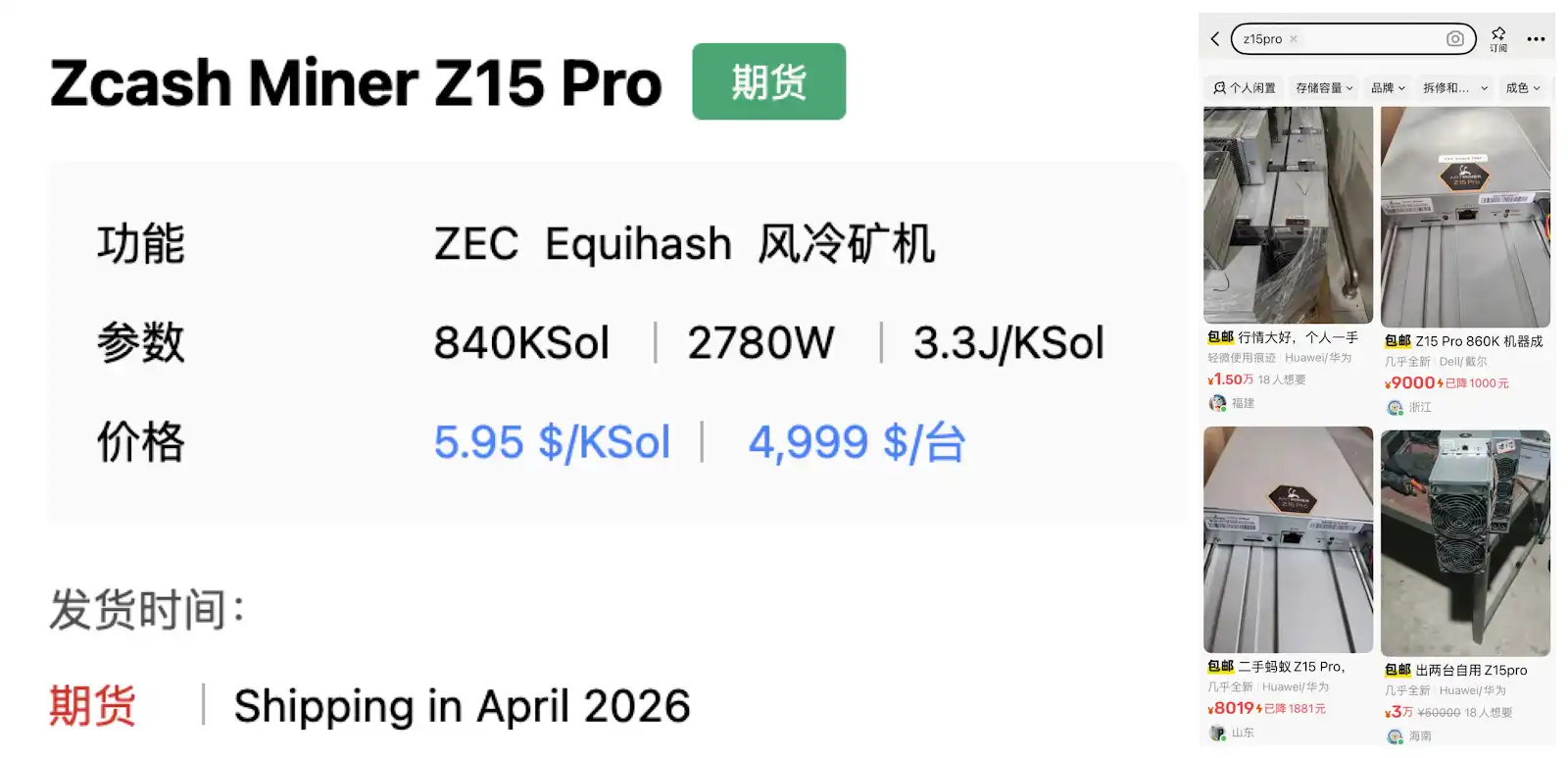
2) ZEC Hashrate and Mining Revenue: Amazing Daily Returns
Over the past two months, ZEC's high returns have been rapidly attracting hashrate to enter the scene, and the overall network hashrate has started to grow significantly, while the difficulty has also entered an upward cycle. As can be clearly seen from the chart, ZEC's price (yellow line) began to break out of consolidation at the end of September, with hashrate (light purple) and difficulty (dark blue) rising synchronously. This trend indicates that the mining side has begun to react to the price increase.
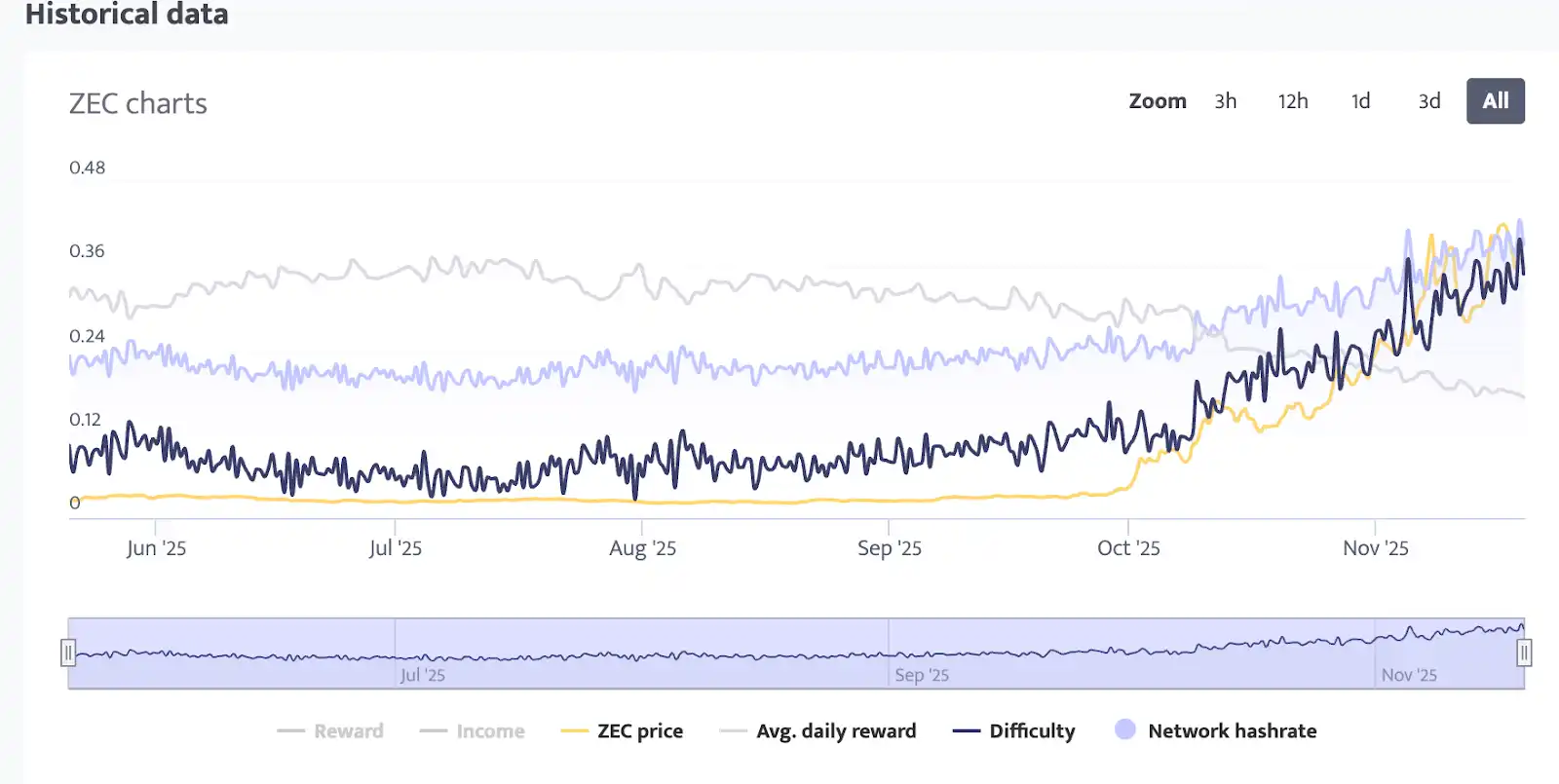
As of the time of writing, the key parameters of the Zcash network are:
• Network Hashrate: 13.31 GH/s
• Network Difficulty: 118.68M
• Block Reward: 1.5625 ZEC
To calculate daily revenue, we will input the parameters of the Z15 Pro into the mining revenue calculator and follow standard miner settings:
• Pool Fee: 2%
• Electricity Price: $0.08 / kWh
• Daily Electricity Cost: $5.34 (2.78 kW × 24 hours × $0.08/kWh)
Then we can derive an astonishing number: the net daily income of a single Z15 Pro is close to $60! Moreover, from historical data, such a high return has been sustained for at least 1 week.
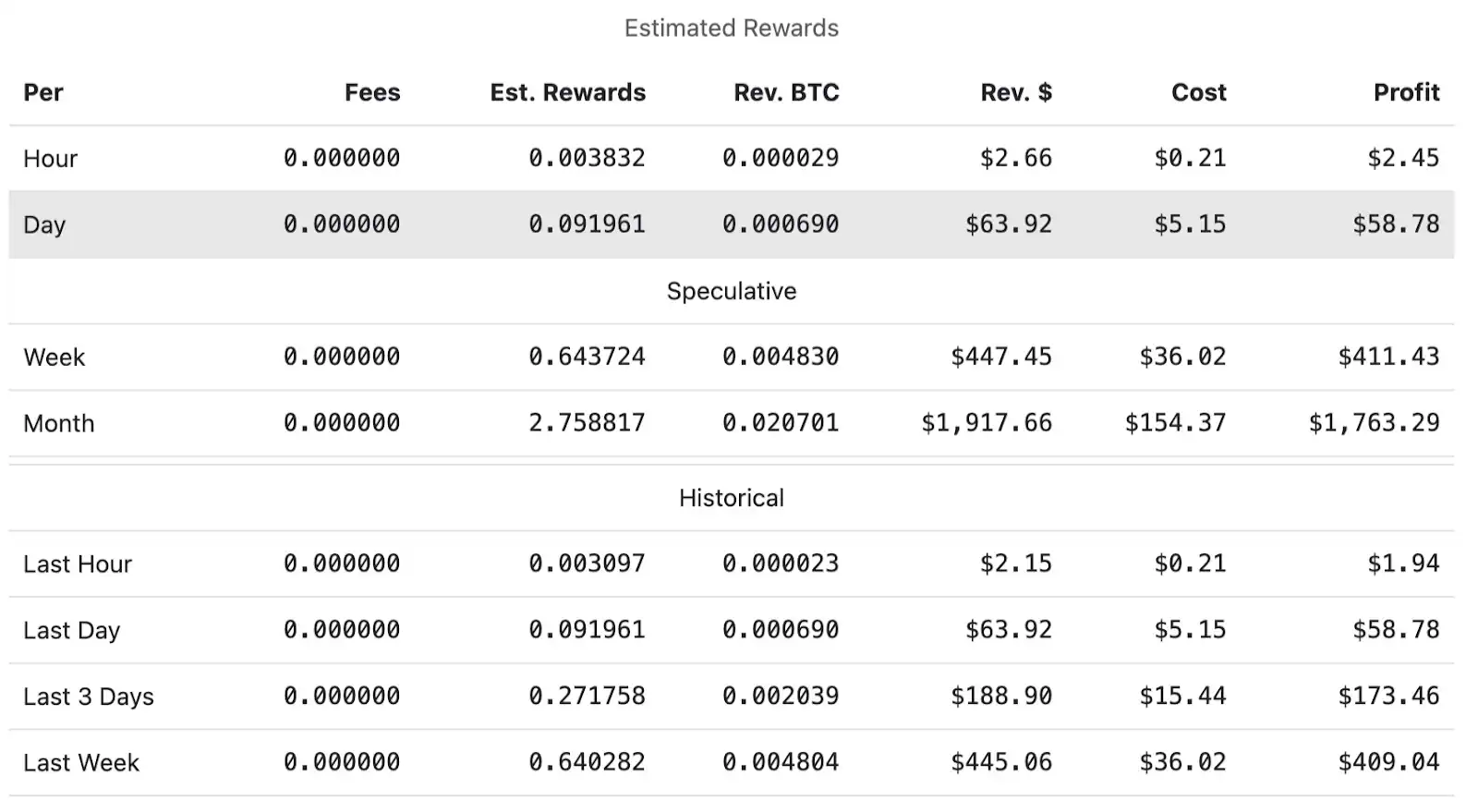
3) Payback Period: Extremely Rare High ROI
Assuming the network difficulty remains stable in the short term and the electricity cost is constant, we use the Z15 Pro mining machine futures price of $4,999 to calculate the payback period.
To reflect the actual cost, we will depreciate the machine over 5 years (1826 days) in a straight-line manner:
• Daily Machine Cost Depreciation: $2.74
• Consider the daily net income after amortization: about $56.04
Therefore, the payback period for a single Z15 Pro is only about 89 days, with an annualized return rate of up to 410%.
This number is extremely rare in the entire PoW history—some might even say it is exceptional:
• The payback period for BTC miners usually ranges from 12 to 24 months during a bull cycle
• ETH PoW era miner ROI falls between 300 and 600 days
• Any PoW project with a payback period of less than 120 days (FIL, XCH, RVN, etc.) has almost always experienced a pump-and-dump scenario

4) Case Study: The Repeated Drama of the Hardware–Price Scissors
The Hardware-Price Scissors is a recurring "harvesting" script in PoW mining history, where miners, at the peak of the coin price and FOMO sentiment, order miners at a multiple markup price (at this point, the ROI looks very low, with a payback period of only 4 months). However, when the miners are actually delivered and deployed, with hashrate surging (often delayed by more than 3 months), whales often sell at the top, causing miners to face a double blow of "coin price crash + yield crash," turning their expensive miners into instant scrap metal.
• In May 2021, Chia caused a global hard drive shortage. At the time, XCH's price soared to $1,600, and the early hard drive investment showed a payback period that was once compressed to less than 130 days. This extreme windfall instantly triggered a global storage hashrate tsunami. However, what followed was a brutal "scissors difference": despite the price drop, the previously ordered hard drives continued to come online, and the network's hashrate continued to surge after the price peak, rapidly extending the payback period from 30 days to over 3,000 days.
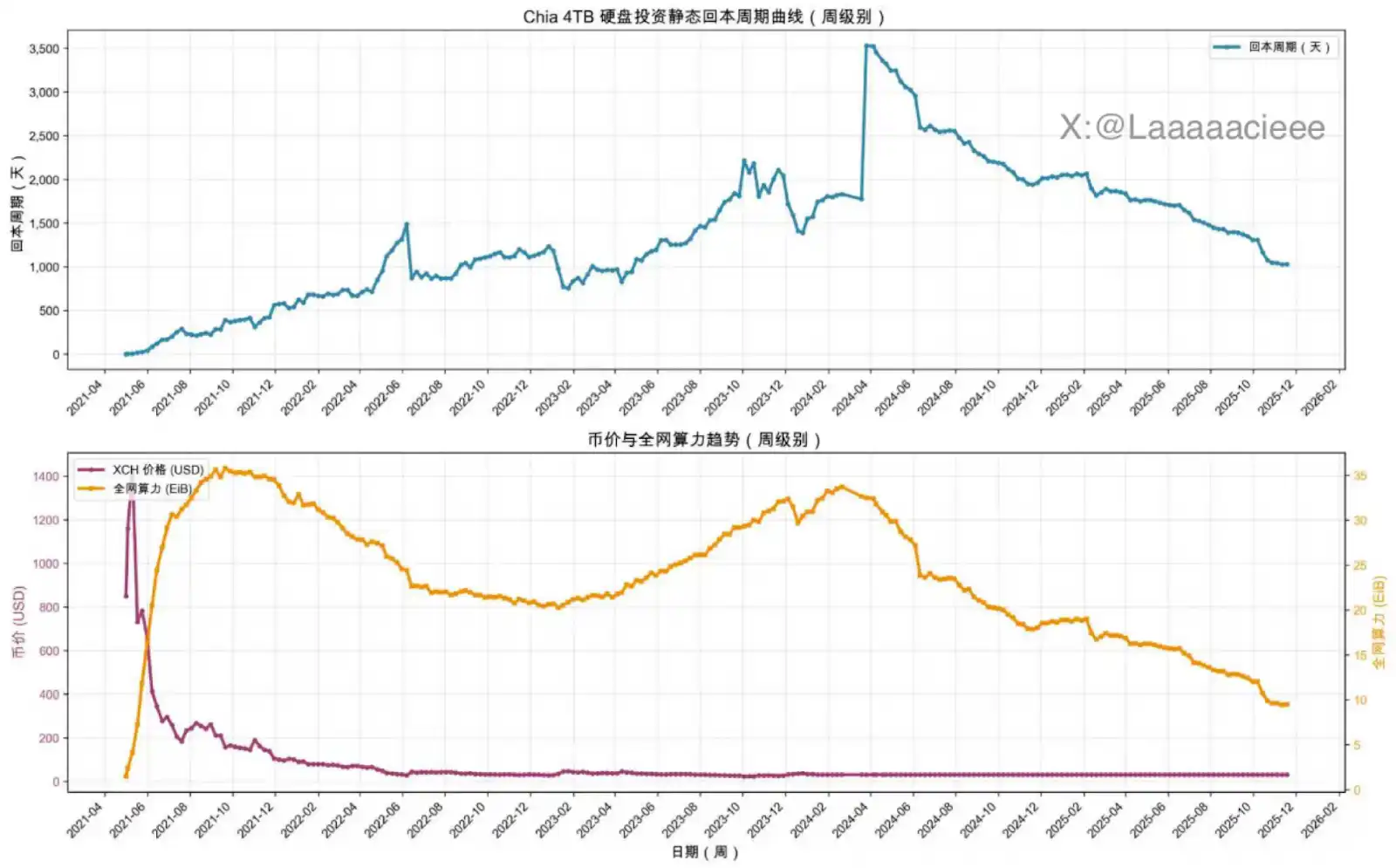
Looking at the data of the IceRiver KS1 miner, by mid-2023, its payback period temporarily dropped to 150 days. Unlike Chia, the KAS price even maintained an upward trend. However, miners still operated at a loss, because the hashrate growth rate far exceeded the price increase rate. The rapid iteration and large-scale deployment of industrial-grade ASICs led to an exponential increase in network difficulty. Despite the strong price, due to the sharp rise in difficulty, the payback period for this machine, KS1, irreversibly spiked to 3,500 days.
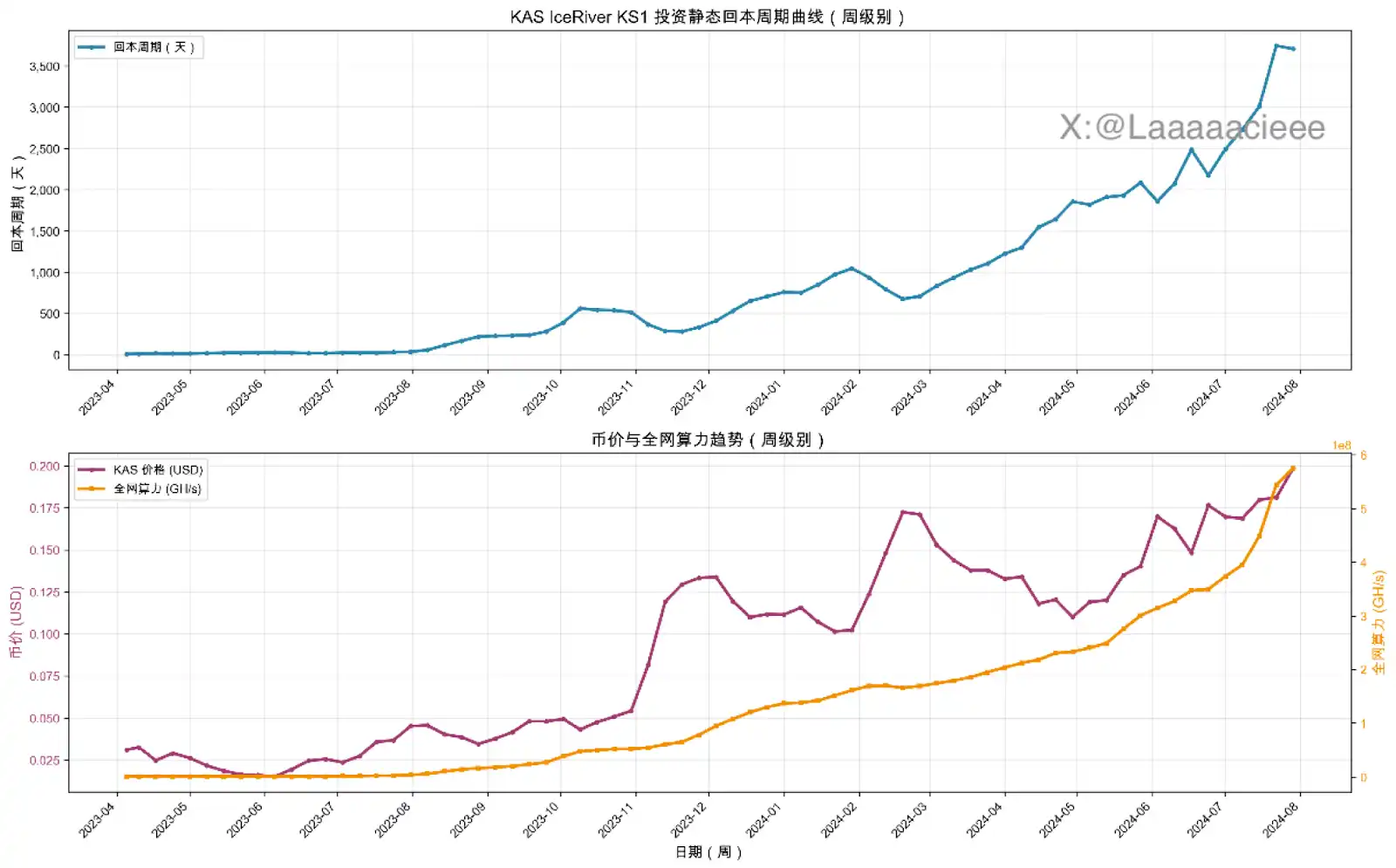
ZEC's Hash Rate Level is Currently in the Danger Zone of Multiple Historical 51% Attacks
Outside of the mining economic model, another critical risk line is the network's security and hash rate scale. For a PoW chain, the "total network hash rate + 51% attack cost" directly determines whether it can be self-consistent in a high valuation state.
1) Total Network Hash Rate: Only Equivalent to a Small to Medium-sized Bitcoin Mining Farm
As of the time of writing, ZEC's total network hash rate is approximately 13.31 GSol/s. Calculated with the Z15 Pro's hash rate of 0.00084 GSol/s per unit, only about 14,857 Z15 Pro miners are needed, with a corresponding power consumption of about 40 MW, which is only equivalent to the scale of a small to medium-sized Bitcoin mining farm.
From the perspective of the entire network's hash rate, Zcash's security foundation appears extremely weak, having entered the danger zone of many small PoW chains that have been successfully 51% attacked.
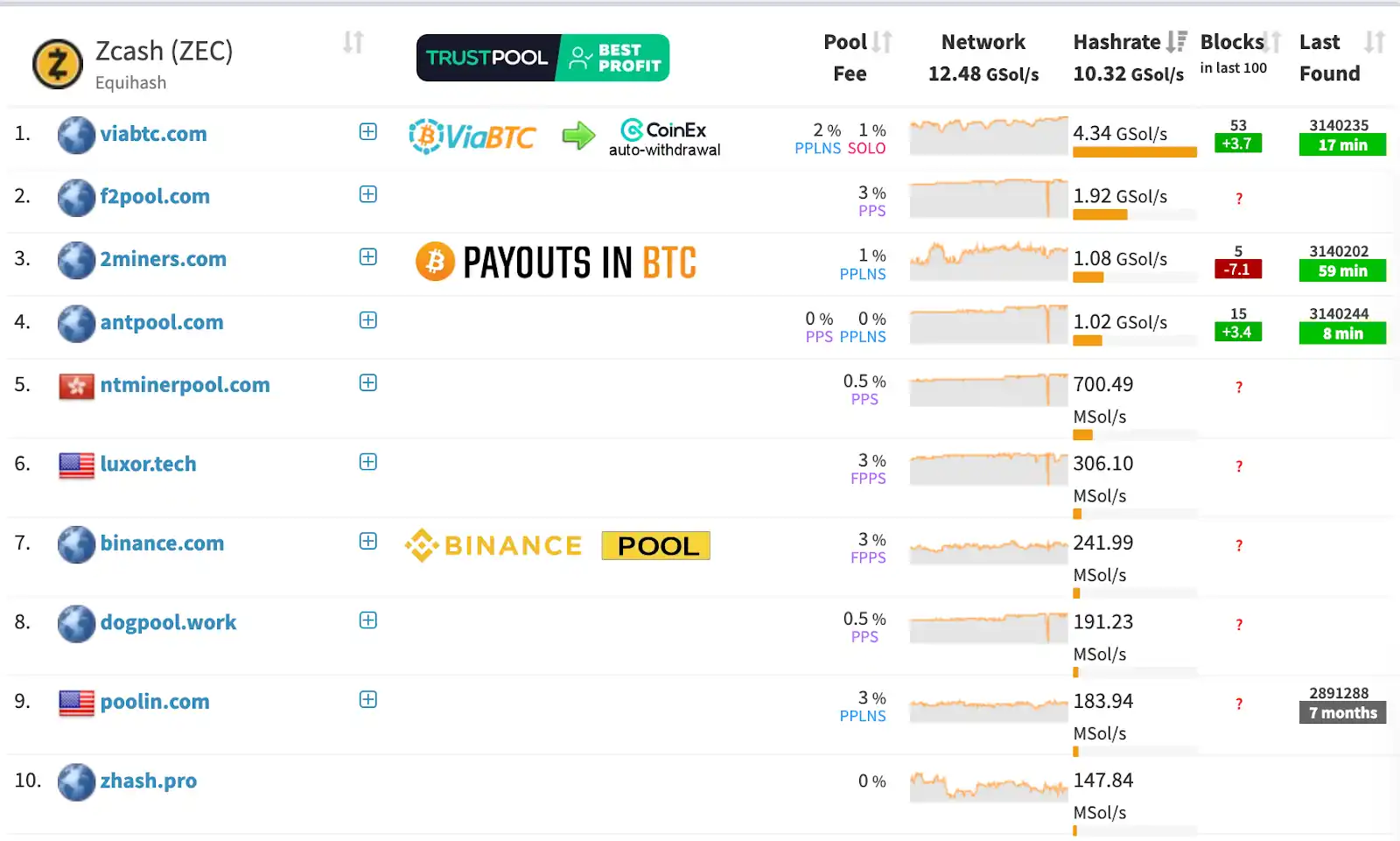
2) Attack Cost: Theoretical Cost is Only in the Millions of Dollars
Generally speaking, initiating a 51% attack requires controlling over 50% of the total network's hash rate at the same time. If nearly 16,000 Z15 Pro units in the ZEC network constitute the main force, then an attacker would only need to rent or buy thousands of devices to potentially control over 50% of the hash rate.
Rough Estimation:
• Each Z15 Pro's futures cost ~$5,000, typically 300 units or more qualify for large-volume purchase discounts of at least 10%
• Controlling hash rate of ~8,000 units → Cost at most ~$40M, with power consumption for the attack at around 20 MW
• If leasing or second-hand prices are lower, the actual startup cost could be in the millions of dollars
In a public chain with an FDV of nearly tens of billions of dollars, an investment of only a million-dollar level in hash rate is sufficient to launch a potential chain reorganization or double-spend, which is itself a structural risk that is hard to ignore.
3) Compared to Mainstream Chains: Enormous Security Gap
In order to give everyone a more intuitive and clear perception, let's make a simple comparison with other operating large PoW chains:

More critically, ZEC's current hash rate is not only far lower than mainstream PoW chains such as BTC/LTC/KAS, but even lower than ETC, BTG, VTC, BSV, which have been successfully 51% attacked in the past. At the time of the attacks, the hash rate of these chains was generally higher than ZEC's current hash rate, indicating that ZEC's network security has actually fallen into a vulnerable range for attack.
On-chain Data Reveals ZCash's Actual Usage Is Still Very Limited
Despite the recent heating up of the ZEC narrative, on-chain data provides a more sobering perspective — there is a significant deviation between actual usage and the current multi-billion-dollar FDV.
From transaction volume, active addresses to ecosystem scale, Zcash's actual network behavior is far from as prosperous as the price trend suggests:
• The average daily transactions in the past month are only 15,000 – 18,000 transactions/day, which is only 1% – 2% of a large-scale public chain
• As a privacy chain, the vast majority of transactions are still transparent transactions, with shielded transactions accounting for less than 10%

Repricing When the Market Returns from Frenzy to Calm
Narratives, emotions, celebrity effects, and the miner economic trap have collectively pushed a dormant project of eight years to the peak of public opinion. But looking beyond the noisy facade, when we truly return to the three core aspects of blockchain: economic sustainability, network security, and on-chain adoption, ZEC presents a completely different picture.
These are:
• Break-even in just 89 days, with a 410% annualized siege miner rotation
• The hash rate scale is only equivalent to a medium-sized Bitcoin mining farm, with a 51% attack cost as low as a million dollars, transaction volume and daily active users only accounting for 1%–2% of mainstream public chains, and the actual usage of privacy features being less than 10% on this PoW chain.
History has repeatedly proven: an extremely short breakeven period (ultra-high ROI) is often a precursor to a mining crisis and price collapse.
Whether ZEC will be an exception, I cannot say.
But the rules of the crypto world have never changed: narratives and emotions can create myths, but fundamentals determine how far myths can go.
Disclaimer: The content of this article solely reflects the author's opinion and does not represent the platform in any capacity. This article is not intended to serve as a reference for making investment decisions.
You may also like
Bitcoin Likely to Remain Under Pressure as Massive ETF Outflows Shake the Market
XRP Price Prediction: Is This Dip a Buying Opportunity?
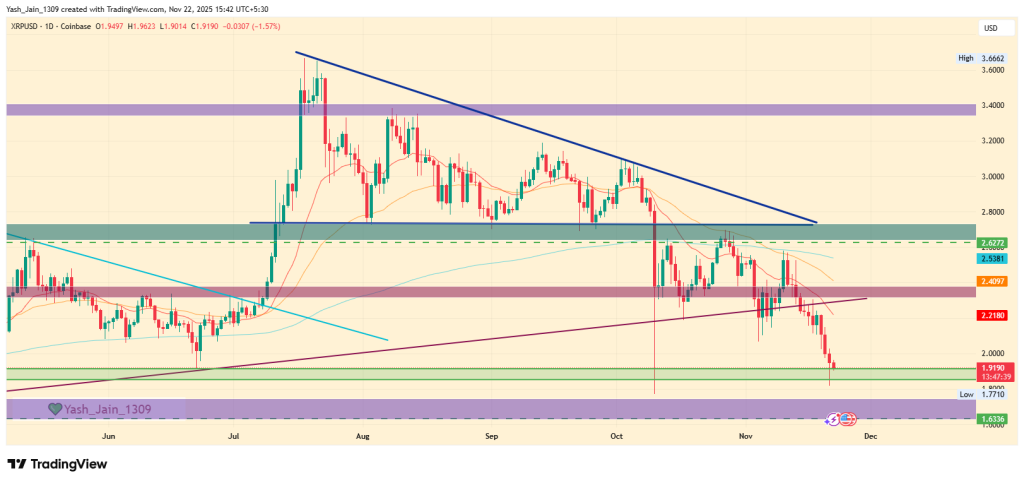
VanEck CEO Flags Quantum Threat to Bitcoin; Firms to Walk Away?
Crypto Eyes Relief Rally as December Fed Rate Cut Odds Surge to 71%
